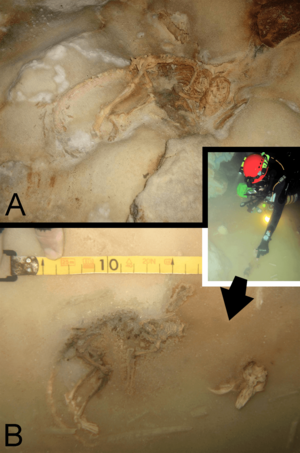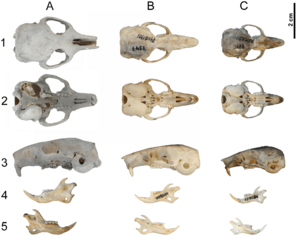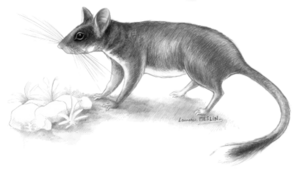Hypnomys facts for kids
Quick facts for kids Hypnomys |
|
|---|---|
 |
|
| H. morpheus | |
| Scientific classification |
|
| Kingdom: | Animalia |
| Phylum: | Chordata |
| Class: | Mammalia |
| Order: | Rodentia |
| Family: | Gliridae |
| Subfamily: | Leithiinae |
| Genus: | †Hypnomys Bate, 1918 |
| Type species | |
| †Hypnomys mahonensis Bate, 1918
|
|
| Species | |
|
|
Hypnomys, also known as the Balearic giant dormouse, was a type of dormouse that is now extinct. These animals were much larger than regular dormice. They are a great example of island gigantism, which is when animals on islands grow much bigger than their relatives on the mainland.
These giant dormice lived only on the Balearic Islands in the western Mediterranean Sea. They were there from about 5 million years ago until they died out around 4,000 years ago. Hypnomys first appeared on the island of Mallorca. Scientists think they arrived there when the Mediterranean Sea partly dried up, creating land bridges. Later, they spread to Menorca, and a possible tooth has also been found on Ibiza. Hypnomys disappeared after humans arrived on the Balearic Islands. They were one of only three native land mammals living on the islands when humans first got there. The others were a shrew called Nesiotites and a goat-antelope named Myotragus.
Contents
Discovery of Hypnomys
The first bones of Hypnomys were found in 1910 on the island of Mallorca. They were discovered by a British scientist named Dorothea Bate. A year later, she also found remains on Menorca.
At first, Bate thought these fossils belonged to other types of dormice. But in 1918, she realized they were unique. She then named the new group Hypnomys. She described two species: H. morpheus from Mallorca and H. mahonensis from Menorca.
How Hypnomys Evolved
Scientists have studied the Mitochondrial DNA from H. morpheus. This DNA shows that Hypnomys is related to garden dormice (Eliomys). They are not as closely related to other dormouse types like mouse-tailed dormice or hazel dormice.
Using a method called a molecular clock, scientists estimate that Hypnomys and modern Eliomys split apart about 13.67 million years ago. The ancestor of Hypnomys is often thought to be an ancient Eliomys species called E. truci. This animal lived in Spain a very long time ago. However, some features of the earliest Hypnomys teeth suggest they might have come from a different, now extinct, dormouse group.
Hypnomys likely arrived in Mallorca during the Messinian salinity crisis. This was a time, about 5.96 to 5.3 million years ago, when the Strait of Gibraltar closed. The Mediterranean Sea partly dried up, exposing land that was usually underwater. This created land bridges, allowing animals to travel from mainland Europe to the Balearic Islands. After this, the sea refilled, and the islands became isolated again. This long isolation allowed Hypnomys to evolve into its unique giant form.
By the Late Pliocene (around 2.5 million years ago), Hypnomys was one of only three mammals on Mallorca. The others were the goat-antelope Myotragus and the shrew Nesiotites. These three animals later spread from Mallorca to Menorca. This likely happened when sea levels were lower during ice ages, connecting the islands. A tooth that might belong to Hypnomys has also been found on Ibiza.
Types of Hypnomys
Scientists have identified several species of Hypnomys. These species lived from the Pliocene to the Holocene periods. Many of them are considered chronospecies. This means they evolved one after another from earlier species. Scientists mostly tell them apart by looking at their teeth.
Here are some of the known species:
- Hypnomys waldreni (lived in the Middle-Late Pliocene on Mallorca)
- Hypnomys onicensis (lived in the Early Pleistocene on Mallorca)
- Hypnomys eliomyoides (lived in the Early Pleistocene on Menorca)
- Hypnomys morpheus (lived from the Middle Pleistocene to the Holocene on Mallorca)
- Hypnomys mahonensis (lived from the Late Pleistocene to the Holocene on Menorca)
Some very old Hypnomys remains from the Early Pliocene on Mallorca haven't been assigned to a specific species yet.
There was also a species called Hypnomys gollcheri from Malta. However, scientists later decided it belonged to a different group called Maltamys.
While some scientists once thought Hypnomys was just a subgroup of Eliomys, most now agree it's a separate and distinct group of dormice.
The H. mahonensis from Menorca was generally larger than H. morpheus from Mallorca. It also had simpler teeth. However, the size of H. morpheus changed a lot during different ice ages. Sometimes, it grew as big as H. mahonensis.
What Hypnomys Looked Like

Hypnomys was much larger than dormice living today on the mainland. Over time, the Hypnomys lineage gradually grew bigger.
One fossil of Hypnomys measured about 15 centimeters (6 inches) long from head to body. Its tail was about 10 centimeters (4 inches) long. A larger H. morpheus specimen was about 18 centimeters (7 inches) long with a tail of 11.5 centimeters (4.5 inches). Their tails were shorter in proportion to their bodies compared to modern dormice. Scientists estimate that an H. morpheus could weigh between 173 and 284 grams (0.38 to 0.63 pounds).
The skulls and jaws of Hypnomys were very strong and thick. This suggests they had powerful chewing muscles. Their leg bones were also strong.
How Hypnomys Lived
A study of H. onicensis bones showed that these giant dormice could live for over 10 years. This is a very long lifespan compared to living dormice, which usually live up to 5 years. Young Hypnomys babies were already much larger than young modern dormice. They also likely took longer to become adults.
By studying tiny scratches on the teeth of H. morpheus, scientists found that these dormice ate many different things. They were more omnivorous than garden dormice, which eat a lot of meat. The pits on their teeth suggest they ate hard foods like nuts and seeds, or even grit.
Scientists have debated how Hypnomys lived. Some studies suggested they spent more time on the ground than modern dormice. However, other studies found that H. morpheus likely lived in trees. They might have also been able to dig.
Even though the Balearic Islands didn't have large land predators, Hypnomys was hunted by birds of prey like owls.
Why Hypnomys Died Out
Like the other two native mammals on the Balearic Islands, the shrew Nesiotites and the goat-antelope Myotragus, Hypnomys likely died out quickly after humans arrived. Humans came to the Balearic Islands around 4,500 years ago. The latest dates for H. morpheus are a few thousand years before humans arrived. However, other animals like Nesiotites and Myotragus were present when humans arrived, suggesting Hypnomys might have been too.
Humans probably didn't hunt Hypnomys directly. Predators like cats, weasels, and genets were brought to the islands much later. There is no strong evidence that dogs were there early on.
Other animals, like the garden dormouse and wood mouse, were introduced to the islands by humans. They might have competed with Hypnomys for food and space. Diseases brought by these new animals might also have played a part in the extinction of the giant dormice.
See also
 In Spanish: Lirones gigantes de Baleares para niños
In Spanish: Lirones gigantes de Baleares para niños
- Quaternary extinction event
- List of extinct animals of Europe
- Leithia a giant dormouse from Sicily and Malta


